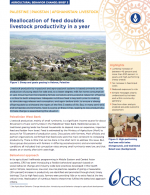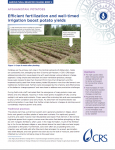Learning Briefs | October 17, 2019
Reallocation of feed doubles livestock productivity in a year
AGRICULTURAL BEHAVIOR CHANGE: BRIEF 3
Livestock productivity in pastoral and agro‑pastoral systems is based primarily on the production of young stock for sale and, to a lesser degree, milk for home consumption or sale. Ensuring that the breeding female conceives and successful raises her offspring is critical to both enterprises. Adequate nutritious feed is key both prior to mating, to stimulate egg release and conception, and again before birth, to ensure a strong offspring able to withstand the rigors of the first 3 weeks of life. But, in many semi‑arid and temperate environments, feed is scarce at these times, leading to low productivity. Climate change is exacerbating the situation.
AGRICULTURAL BEHAVIOR CHANGE BRIEFS: INTRODUCTION
AGRICULTURAL BEHAVIOR CHANGE: BRIEF 1
AGRICULTURAL BEHAVIOR CHANGE: BRIEF 2
AGRICULTURAL BEHAVIOR CHANGE: BRIEF 4
AGRICULTURAL BEHAVIOR CHANGE: BRIEF 5




